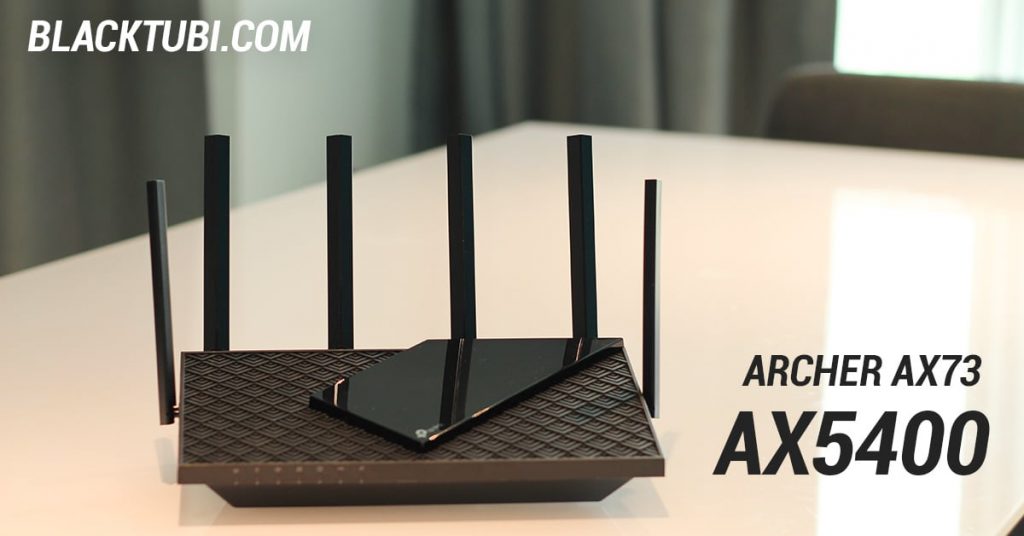
It’s 2021 and the pandemic is still here. This means we’re still working from home until things get better. Having a reliable and fast WiFi connection is crucial for work productivity. Thus, that brings us to the new TP-Link Archer AX73, a high-performance AX5400 wireless router now available in Malaysia.
The Archer AX73 is a high-performance WiFi 6 router. It can support total WiFi link speed up to 5400Mbps with dual-band configuration. In fact, the router supported the 160Mhz mode which means the 5Ghz WiFi network can get really fast if you have a 160Mhz supported WiFi adapter.
What’s so good about the Archer AX73 is the price. It is available for sale at just RM399 in Malaysia with a 3 years one-to-one exchange hardware warranty and after sales support from TP-Link Malaysia.
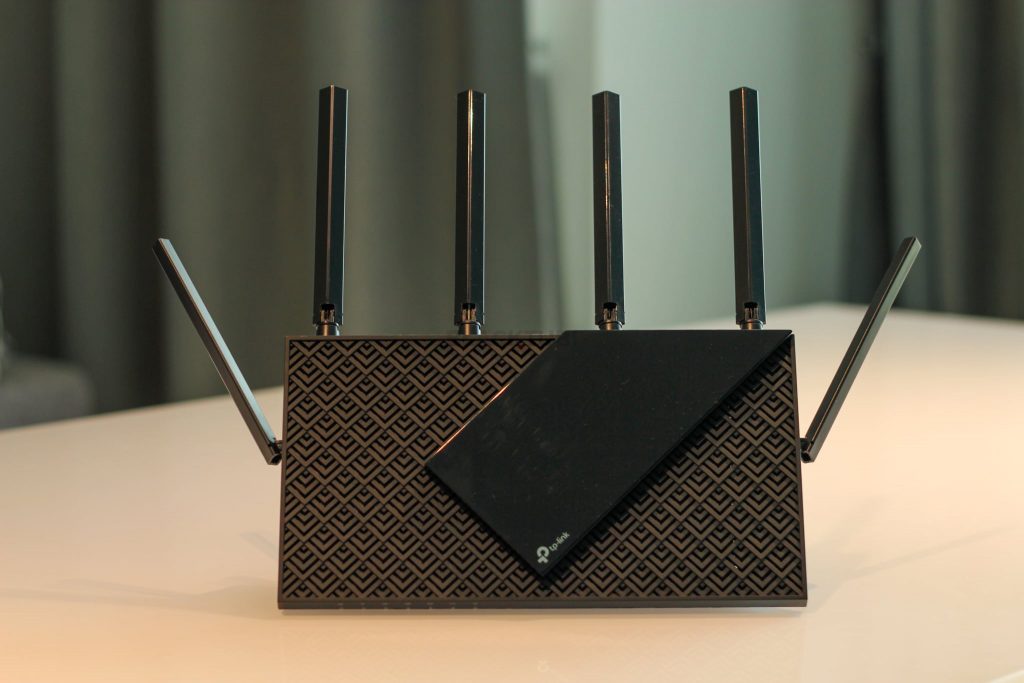
Table of Contents
The first thing that you’ll notice from the Archer AX73 is the 6 antennas. These antennas are real and not just for show. We’ve taken apart router and identified that 4 antennas are used for the 5Ghz network and 2 antennas are used for the 2.4Ghz network.
The reason why there are 6 antennas is because the Archer AX73 uses an individual antenna for each transmit channel rather than combining both the 2.4Ghz and 5Ghz into a single antenna. Rather than using a dual-band antenna, each antennas on the router are optimized for their desired frequency, resulting in better performance without compromises.
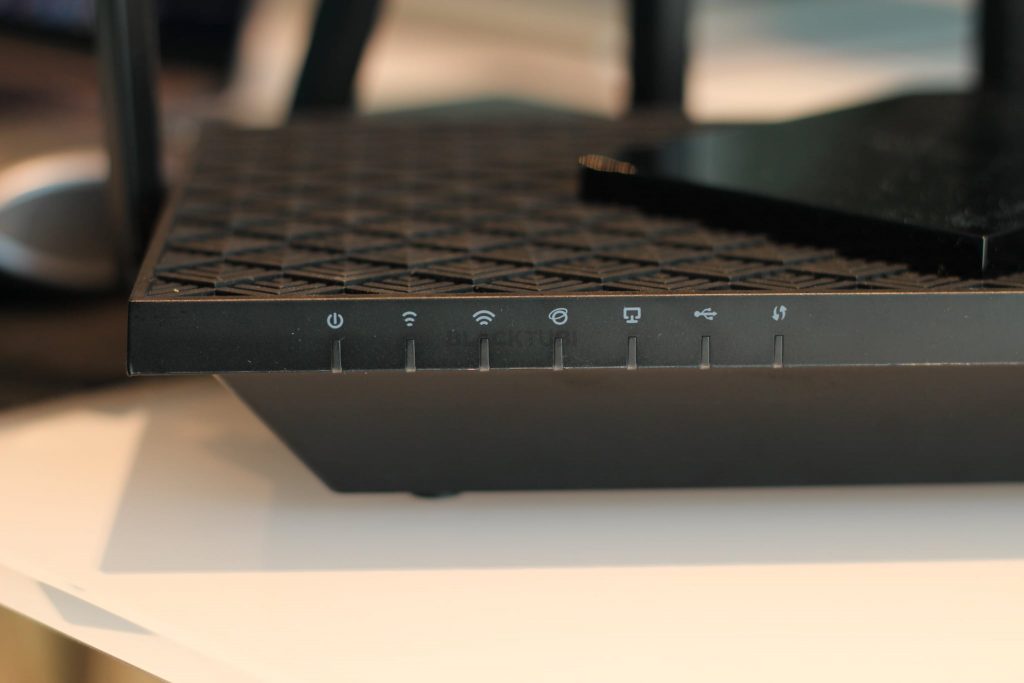
The Archer AX73 also runs really cool and stable in our test. It’s because TP-Link used a much larger heatsink and added more ventilation. This is why the Archer AX73 is so big and heavy! In fact, it barely heats up even on prolonged stress test and certainly much cooler than the infamous Archer AX50.
Hardware and Specs
| Wireless 2.4Ghz | Wi-Fi 6 up to 574Mbps (40Mhz 2X2) |
| Wireless 5Ghz | Wi-Fi 6 up to 4804Mbps (160Mhz 4X4) |
| WiFi Features | OFDMA, MU-MIMO, Beamforming, WPA3, OneMesh |
| CPU | Broadcom BCM6750 1.5Ghz Triple-Core |
| Ethernet Ports | 1x Gigabit WAN port + 4x Gigabit LAN port |
| USB | 1x USB 3.0 port |
The Archer AX73 is powered by a fast Broadcom 1.5Ghz Triple-Core CPU and comes with 512MB RAM. TP-Link says this router can actually support up to 200 devices connected simultaneously. While I don’t have 200 devices to test, the router do work realiably in my home with close to 50 devices connected to it.
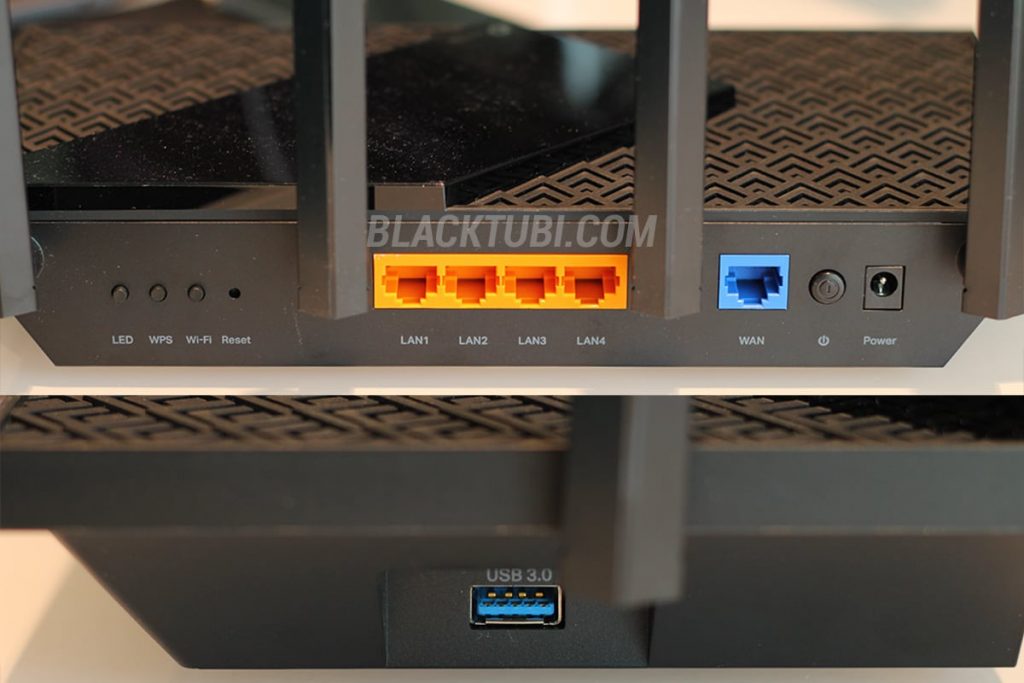
Connectivity wise, the router comes with 4 Gigabit Ethernet LAN ports and a single Gigabit Ethernet WAN port. It also comes with a USB 3.0 port which can be used for file sharing and printer sharing to devices connected to the wireless router. The LED status indicator on the router can be disabled if needed.
Unboxing Archer AX73
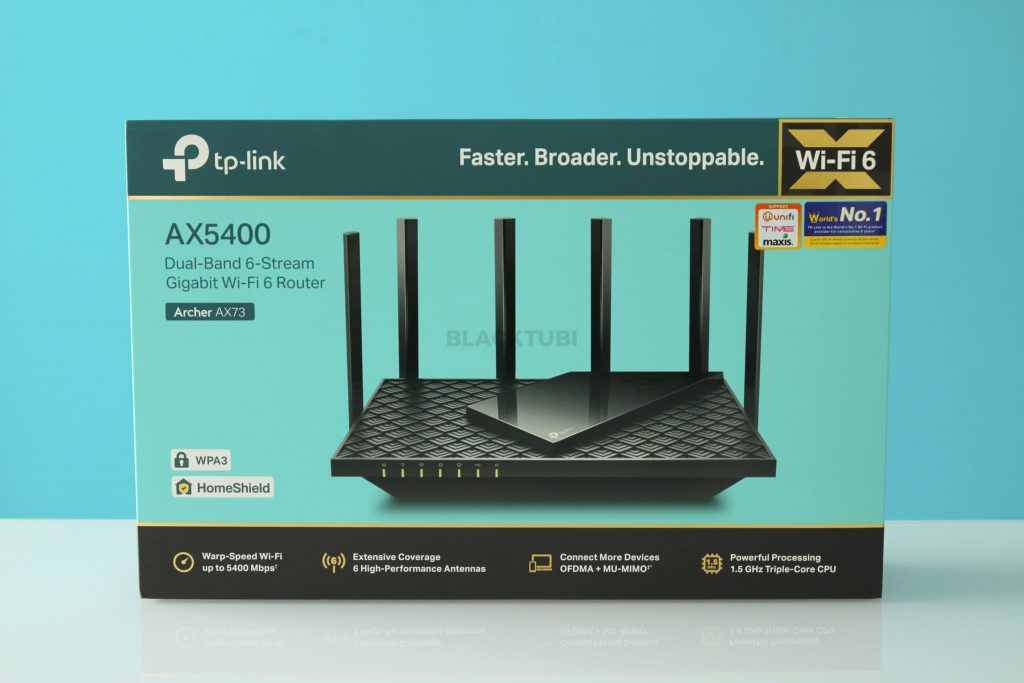
The box of Archer AX73 for Malaysia market comes labeled with support for TM Unifi, Maxis Fibre and TIME Fibre.
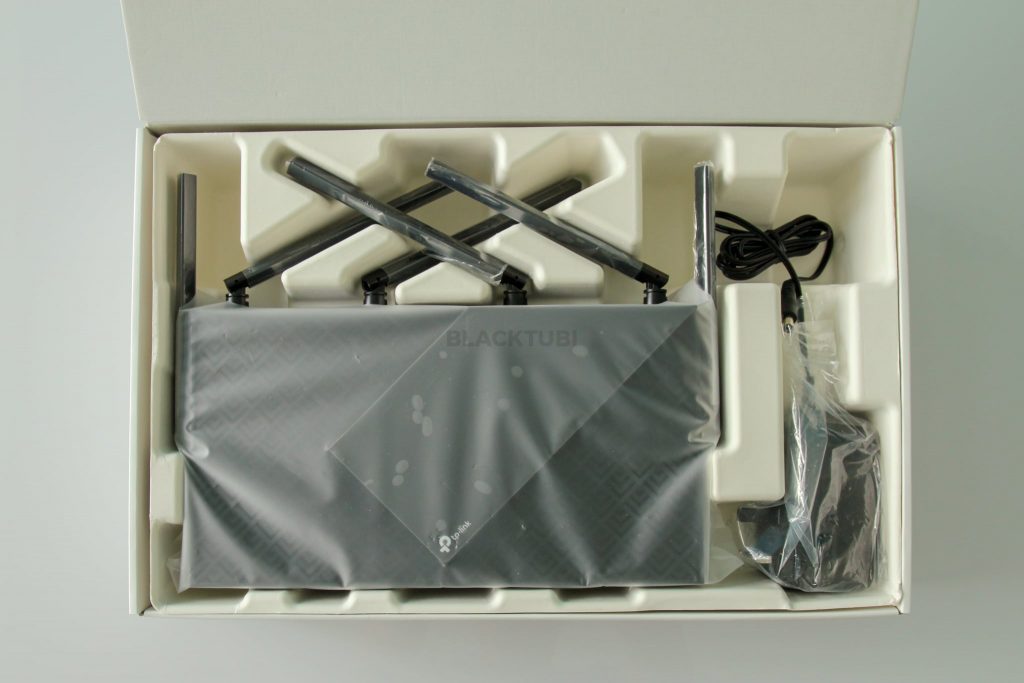
Each antenna on router and accessories are individually wrapped. The cardboard box also provide sufficient protection during shipping. It comes with a CAT5E Gigabit Ethernet LAN cable and a 12V power adapter.
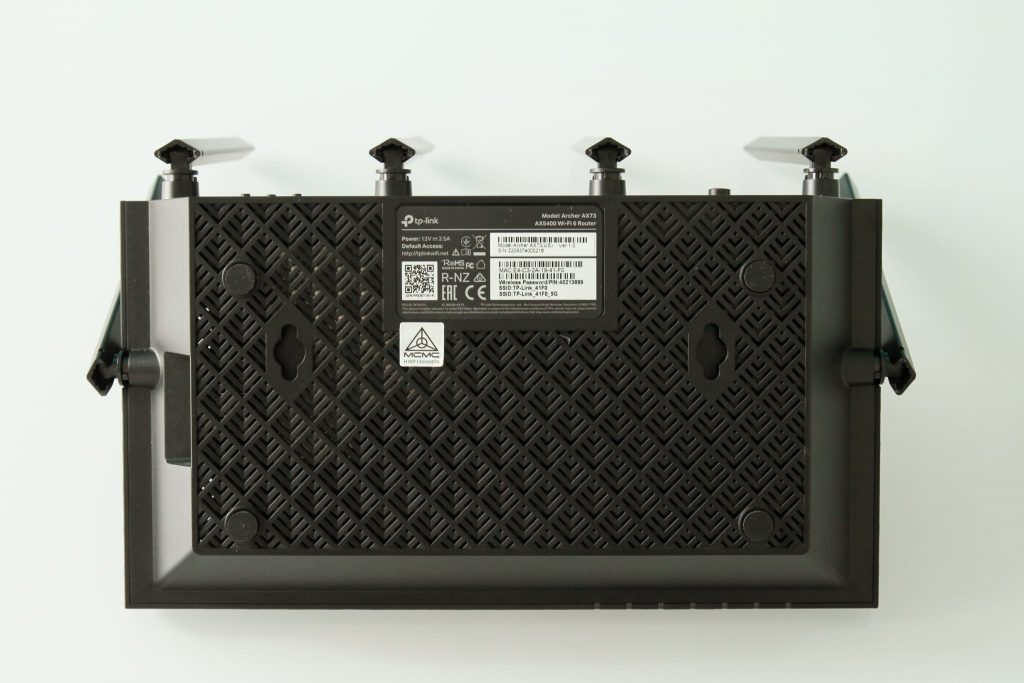
It is possible to wall-mount the wireless router with 2 mounting holes behind the product. The default WiFi name and password is also labeled on the back of the router. Similar to the top, the entire bottom of the product is full of ventilation holes for enhanced cooling performance.
Quick Teardown
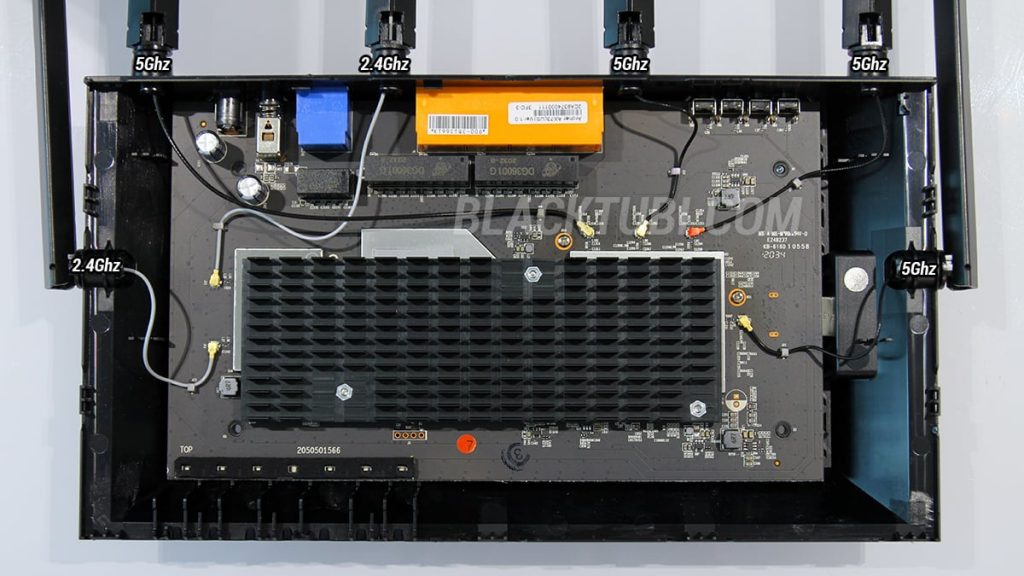
I also did a simple teardown for the Archer AX73. Since I am not a hardware enginee, I won’t comment much about this. WiFi related components are shielded and there’s a decent sized heatsink to cool down the router. This explains why this router barely heats up.
Wi-Fi Performance
With the beefy specifications, let’s see if that actually transfer into actual performance in our benchmark test. I will be using a laptop with the Intel AX200 wireless adapter and an iPhone to test the 5Ghz Wi-Fi 6 performance of TP-Link Archer AX73. I will be skipping the 2.4Ghz result as it is probably irrelevant these days given how congested is the 2.4Ghz channel.
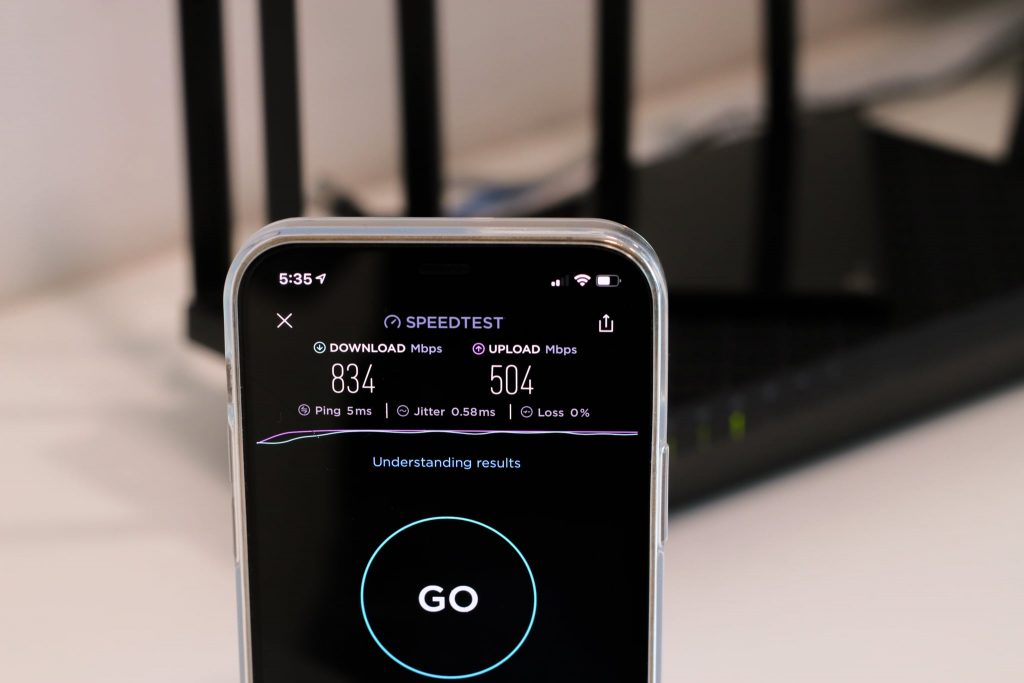
At short distance to the router, my iPhone can achieve over 800Mbps on the 5Ghz Wi-Fi network. This is not surprising considering most Wi-Fi 6 routers, even the budget models like Archer AX10 can deliver such performance. What we really want to know is the long range signal coverage and performance.
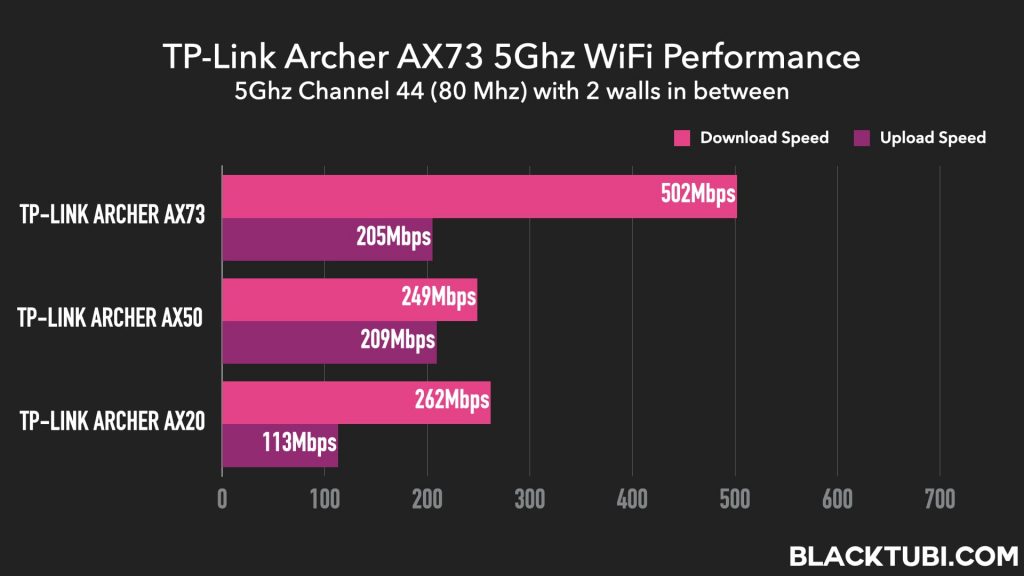
The 5Ghz signal on the Archer AX73 is really strong! The 5Ghz coverage and performance is faster and stronger than every single AX3000 wireless router that we’ve tested on this site. The performance is also stable and consistently replicable througout our review.
Security wise, it can support the latest WPA3 security right out of the box. However, I do not recommend using WPA3 as older WiFi devices may face compatibility issues. Considering a router last many years, you can consider enabling it few more years in the future as older devices are phased out from your home.
Firmware and Features
TP-Link maintain their philosophy of not overly bloating the firmware with features and I think it works here. Reliability is the keyword here as I find the Archer AX73 firmware is very well optimized. During my test, I do not face any issues with the router. The firmware always responded fast consistently.
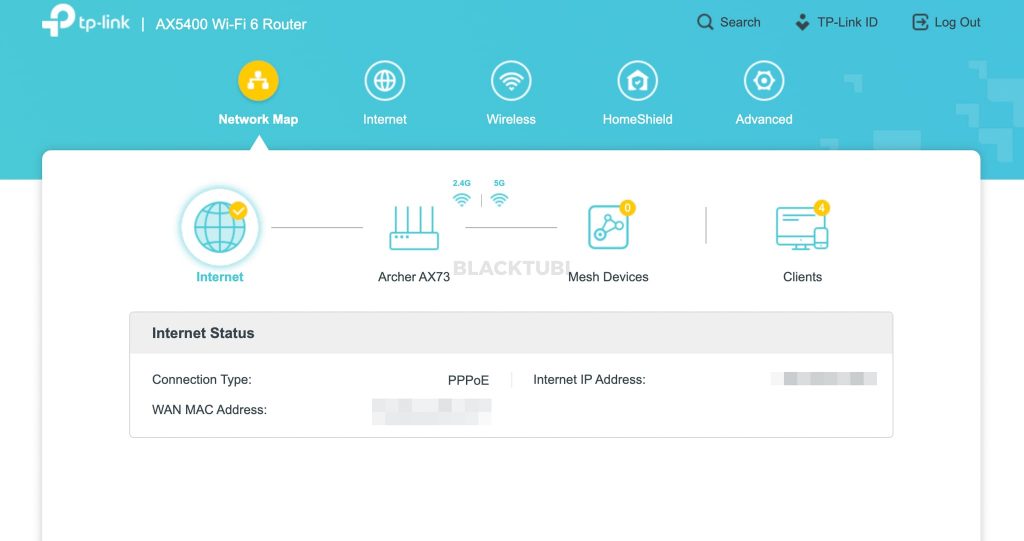
The web interface is simple to operate and certainly very easy to setup the router. It can support TM Unifi, Maxis Fibre and all ISPs in Malaysia. For most users, it will involve connecting the router to the modem and use the setup wizard on the interface. The VLAN profile must be selected for TM Unifi or Maxis Fibre users in Malaysia.
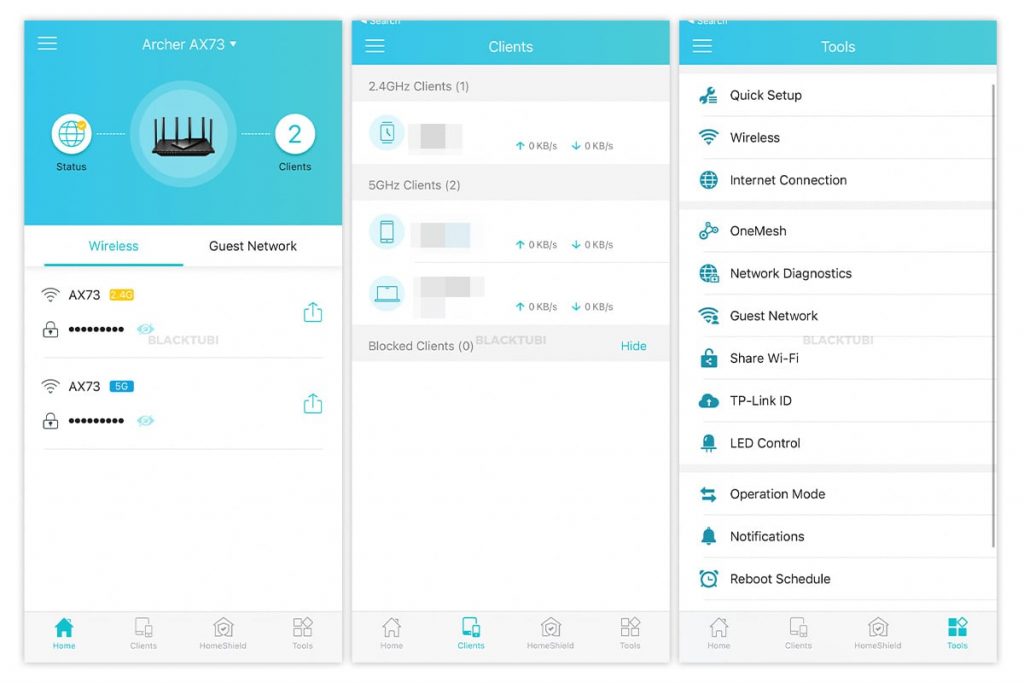
TP-Link Tether app offers a quick overview of your home network condition such as connected devices and network speed. The app is well designed and really responsive in our test. It is securely linked to TP-Link cloud and authenticated with your personal TP-Link account. TP-Link HomeShield security feature is only accessible on the app as well.
TP-Link HomeShield Security
TP-Link HomeShield is their new commercial grade firewall replacing the previous HomeCare feature. It can protect your devices from accessing a malicious website containing a virus or malware with an advanced antivirus firewall. This feature is now powered by Avira Antivirus database.
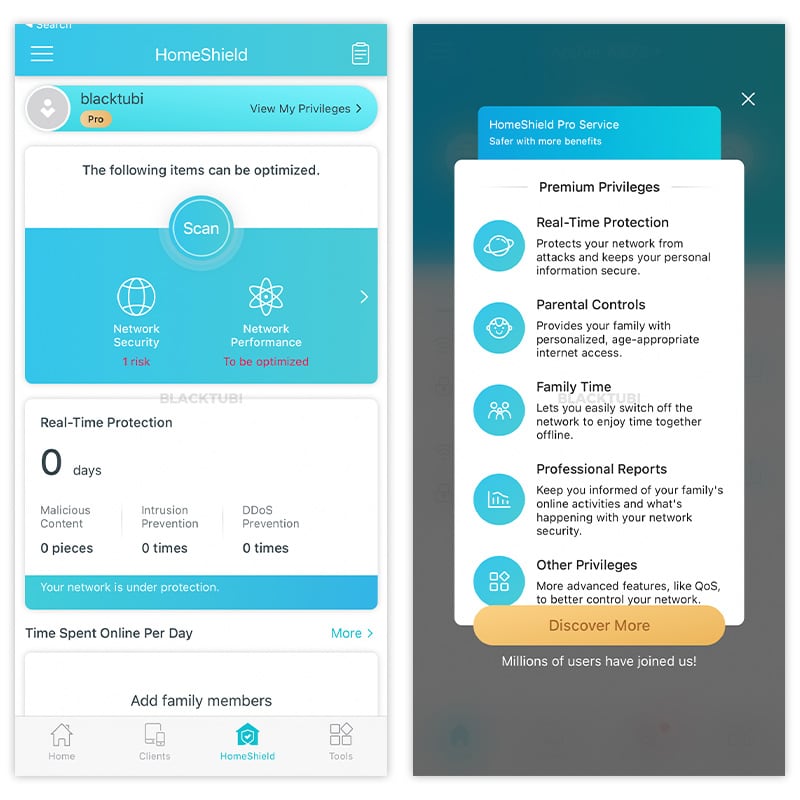
It also added protection for smart home and IoT devices. Considering these devices rarely receive firmware updates, having extra protection is certainly helpful. TP-Link claims it can protect an insecure device from being used as a loophole to launch attacks on your home network. We have no way of verifying these claims.
HomeShield Parental Control
TP-Link new HomeShield parental control is also much smarter than before. It can perform content filtering by category and usage time limitation. The categories are more comprehensive covering more websites than before. Based on our testing on some known sites, it is certainly more effective than HomeCare and other similar systems that we have tested on other brands.
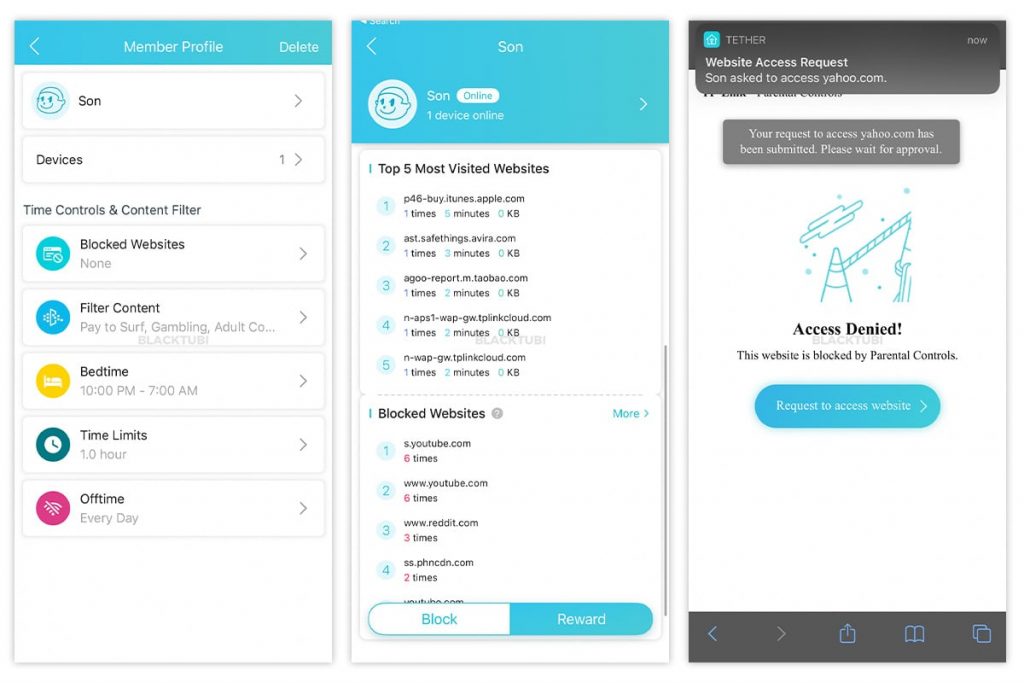
What’s so great about the new parental control is the ability to display usage charts and web history. It will show the top browsed website and attempts to access a blocked website by each user. If a page is blocked by the parental control feature, the user can request for access in which the admin can approve it via the TP-Link Tether app.
However, the upgraded HomeShield feature is not fully free. The Free tier only comes with the basic firewall without the advanced malicious content filtering feature. It also does not provide the comprehensive reporting of the parental control feature. More details available on TP-Link website here.
TP-Link HomeShield feature is a really robust parental control. While TP-Link provide a 30 days free trial of the Pro tier, it will cost RM24.90 per month after the trial has ended. I am fine with a subscription based business model but I find the price is too much.
OneMesh Capability
For those staying in a bigger home, it’s possible to link the Archer AX73 with a OneMesh extender. The OneMesh extender will then work together with the Archer AX73 resulting in a stronger WiFi coverage with true mesh WiFi features like seamless roaming and band steering unlike a traditional WiFi extender.
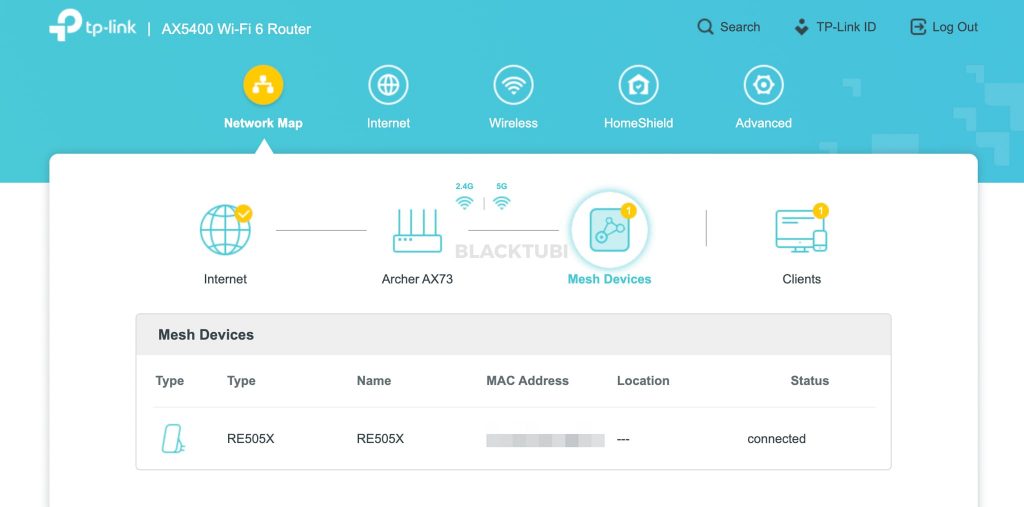
For the Archer AX73, I will only recommend linking it with a WiFi 6 OneMesh extender such as the RE505X and RE605X. Unfortunately, TP-Link does not allow router to router OneMesh currently. You also cannot link the Archer AX73 to a Deco Mesh WiFi system directly as they are based on a different technology.
Closing Thoughts
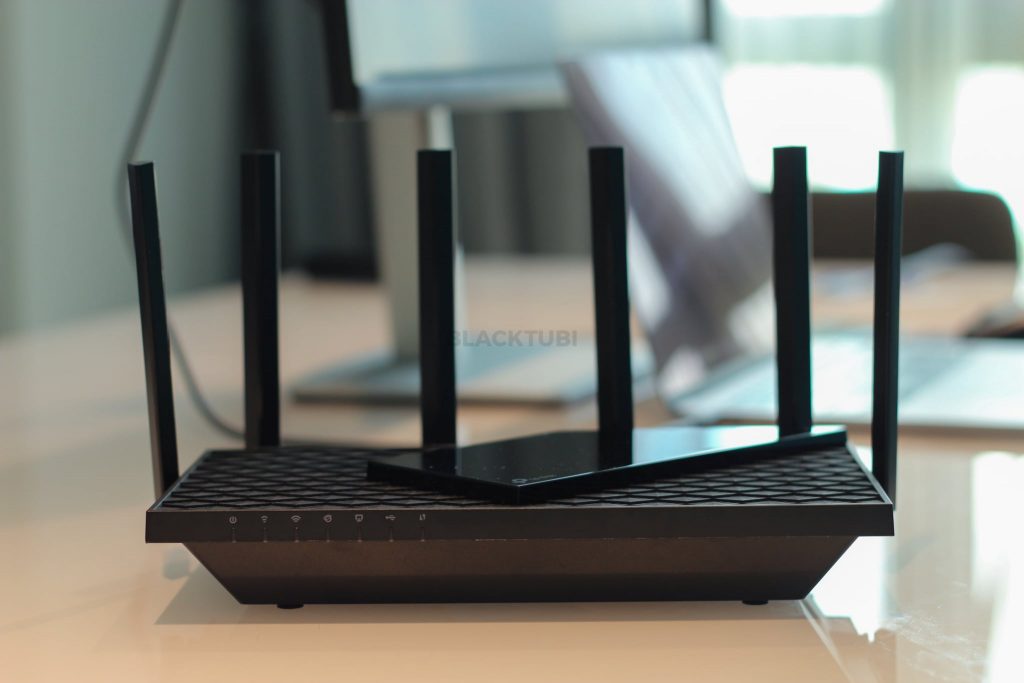
At RM399, the Archer AX73 offers really good performance even when comparing to some other routers that cost twice as much. It offers really good 5Ghz WiFi coverage and very fast WiFi speed on the 5Ghz channel with 160Mhz. Coupled with a fast 1.5Ghz Triple-Core CPU, it is a really good product from TP-Link.
TP-Link software is also smarter than before with a robust class-leading parental control feature. TP-Link is committed to provide more security to smart home and IoT devices with the new HomeSuite security suite. WPA3 security is also supported right out of the box.
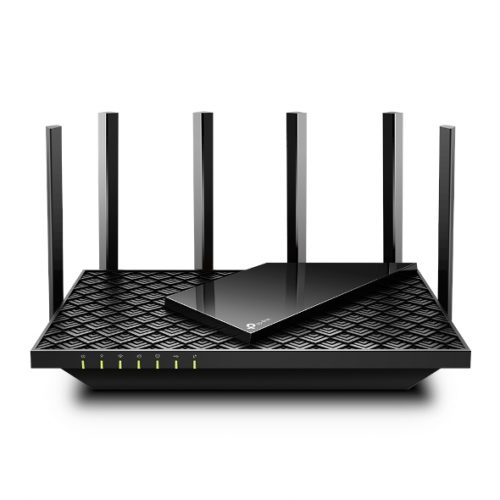
TP-Link Archer AX73
9.2
Tubi Rating
pros
- Premium performance at affordable price
- Robust HomeShield parental control solution
- Stable and reliable software
- Good security
CONS
- Advanced HomeShield features require a subscription
- Limited OneMesh support

After the free trial, can I use the HomeShield Free tier without paying the monthly fee?
Yes, you can.
Does the HomeShield Free tier have free antivirus?
You can refer to TP-Link official portal for the latest updated info. They do update this from time to time.
https://www.tp-link.com/us/homeshield/
Hello again,
Which one is better Archer AX73 or Asus RT-AX58U?
Archer AX73 have a stronger signal strength than ASUS RT-AX58U.
Hi, could you tell me which one router has a better WiFi cover AX73 or Archer C2300 at 2.4GHz?
I’ve never compared them directly and no longer have the Archer C2300 with me now.
Hi admin, just wanna ask can this router cover for a range more then 40ft?
Shouldn’t be an issue if there’s no wall blocking this.
Why my AX73 after few days i install, (ethernet /cable connection)connection speed drop below 100mbps some time achieve around 120mbps only because my subscription with unifi 500mbps. After i report to TM, their cannot figure out why and i’m try and error off SPI firewall and after few minute, my connection back to normal (500++mbps)…why that this happen? It is safe to off the SPI firewall because i don’t have any other choice (a i already try almost everything)…tq
I think there’s something to do with HomeSuite. Do not enable the HomeSuite QoS feature unless you need it.
thank’s a lot for your reply …a few minutes a go i already disable Homeshield QOS…now i m trying
Today morning i onn back my SPI firewall, than this evening my (ethernet /cable connection)connection speed drop below 100mbps. It’s confirm because of this SPI firewall not because of Homeshield QOS, because Homesield QOS already disable last night and still disable until i post this comment. After 10- 20 sec i off back my SPI firewall, the connection back to normal (500++mbps). i have no choice but to off forever my SPI firewall. This is my first experience with this tplink router because before this i already use other brand like asus and Dlink but never happen like this. My… Read more »
Have you tried to update the software? Maybe it’s good to try a factory reset and see whether that will solve your issue.
The firmware/software already the latest one. Factory reset i never try. But i will try after this…and share here what happen …thank’s for your advice.
I will recommend trying a factory reset first and try not to use any of the HomeShield features unless you need it. I find TP-Link new HomeShield to be pretty aggresive which could be a good thing for some people. For me, I prefer not using it at all.
This week very bad, the connection speed drop below 200mbps..some time below 100 mbps. i already factory reset 2 times using button reset at the back of the router. But still the same…this is bad experience with this brand and model TPlink ax73
Disable 160Mhz mode on the 5Ghz channel. 160Mhz provide a huge performance boost but older devices aren’t very compatible with it.
thank you, i will try
Can I use Ax73 to mesh WiFi with deco m4?
The AX73 and Deco M4 is different mesh technology. They cannot directly link wirelessly which means one of the Deco M4 unit must be wiredly connected to AX73.
Means if i got 2pcs Deco M4, i should wiredly connected to AX73 both of them? Or 1 wiredly direct to AX73 the other 1 just link?
If you can connect both units wiredly to the AX73 then that will be the best.
I read that the 5GHz band is 4×4. Is the 2.4GHz band also 4×4?
No, the 2.4Ghz band is only 2×2.
Which routers do you recommend ASUS or TPLINK? Because I have heard that TPLINK routers have connection drop and heating issues
My suggestion is never be a brand fanboy and choose by the product and requirement itself. Both TP-Link and ASUS have their own problematic products.
I have heard that TP-Link Archer AX73 V2 is out what are the differences from V1? Are there any new features and improvements?
According to my TP-Link rep, they are just making incremental changes to manufacturing so there shouldn’t be any difference in performance. Howver, I do have to stress that this review is based on the V1 hardware version.
Which has better 5G coverage, TP link AX73 and ASUS RT-AX86U ?
While I have not compared them directly in a single test session but based on my results from the past, the RT-AX86U is better on the 5Ghz performance. Not a surprise considering it costs almost 3x as much.
Thanks. In U.S., $250 for AX86U, $200 for AX73. I bought AX86U. Only x1.25 difference.
Yeah, from your review the near distance performance of the RT-AX86U is faster than AX73 (870 vs 834 Mbps). But the long distance test with 2 walls, the AX73 is faster than RT-AX86U (502 vs 498 Mbps).
Again, I do not compare them in the same time. Although my test location is the same, the external interference may change.
Hi.. am using Maxis Fibre 300Mbps, coverage 2500sqft 2-storeyhouse.. its a maxis wifi 6 router. The 2.4GHz has good coverage thru out the house with speed capped at 60Mbps, however 5GHz, as expected not so good coverage (1-3 bars) on 2nd floor, speed 50-100Mbps. I’m thinking of using mesh (Airties or Deco) but after reading yr article/review, now wonder which is better to go. The router/modem is in the 1st floor btw… you mentioned that the setting up for Maxis is difficult? Pls explain further… Thank you for yr opinion & advice…
I will suggest getting Deco as the performance is so much better than the Airties provided by Maxis. I also recommend you to replace the router directly with a mesh WiFi system to get the full benefit of a mesh WiFI.
AX73 works seamlessly in my 2 storey SD, up and low front to back well covered.
are there any roaming assistant feature with this ax73? force disconnection of client when rssi low? thanks
The router support 802.11k/v band steering when smart connect is enabled which is more superior than a manual roaming assistant.
thanks ,smart connect can be enable without OneMesh ?
plan to use 2 ax73
You cannot link 2 units of Archer AX73 in OneMesh for now.
Does the Archer AX73 support IPSec Passthrough?
Yes, it does support IPSec Passthrough which can be toggled under the Advanced > Security > ALG menu.